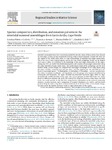Mostrar o rexistro simple do ítem
Species composition, distribution, and zonation patterns in the intertidal seaweed assemblages from Santo Antão, Cape Verde
| dc.contributor.author | Piñeiro-Corbeira, Cristina | |
| dc.contributor.author | Arenas, Francisco | |
| dc.contributor.author | Dolbeth, Marina | |
| dc.contributor.author | Vale, Cândida Gomes | |
| dc.date.accessioned | 2023-05-26T16:42:43Z | |
| dc.date.available | 2023-05-26T16:42:43Z | |
| dc.date.issued | 2023 | |
| dc.identifier.issn | 2352-4855 | |
| dc.identifier.uri | http://hdl.handle.net/2183/33152 | |
| dc.description | Financiado para publicación en acceso aberto: Universidade da Coruña/CISUG | es_ES |
| dc.description.abstract | [Abstract] Intertidal communities have been extensively studied for decades. Many of these studies have focused on macroalgae, as they are key components of many rocky coastal ecosystems. Despite this, there are still regions of the world where there is a lack of knowledge of intertidal macroalgal communities. This is the case in some tropical regions, such as the Cape Verde archipelago, located on the tropical west coast of Africa. To contribute to the knowledge of the macroalgal communities of this region, during July 2022, we studied the distributional pattern and zonation of macroalgal communities along the rocky intertidal of Santo Antão Island, the northernmost island of the archipelago and the least studied. Using a nested design, we compared the macroalgal assemblages of six rocky shores along the entire coastline, including three sites per shore, and four quadrats per site and tidal level. We found 43 macroalgal species – 29 Rhodophyta, 12 Ochrophyta, 2 Chlorophyta – and one Cyanobacteria. The orders Ceramiales, Corallinales, and Gigartinales were the groups more represented, followed by Ectocarpales and Dictyotales. The upper intertidal was dominated by brown algae, while red algae dominated the middle intertidal. Green algae had a scarce presence in both tidal levels. Our results found no differences between the north and south of the island but between rocky shores and tidal levels. Our results provide for the first time comprehensive information on the seaweed community structure, zonation patterns, and a comparison of seaweed abundances in a vertical and horizontal gradient along the entire rocky shores of Santo Antão Island. In the face of the current climate change, our data can be the baseline for future work on algal communities in this región. | es_ES |
| dc.description.sponsorship | Xunta de Galicia; ED481B-2021/095 | |
| dc.description.sponsorship | This research was funded by Fundação para a Ciência e a Tecnologia (FCT), Portugal (DivRestore/0006/2020) through the 2020–2021 Biodiversa and Water JPI joint call for research projects, under the BiodivRestore ERA-NET Co-fund, Portugal (GA N◦101003777). MD was supported by a CEEC contract (CEECINST/00027/2021) funded by FCT, Portugal, and MD, FA, and CV were partly funded by UIDB/04423/2020 and UIDP/04423/2020, all through Portuguese national funds, Portugal. CP-C received financial support from Xunta de Galicia ‘‘Axudas de apoio á etapa de formación posdoutoral, ‘‘ Spain (grant ED481B-2021/095)’’. Funding for open access charge by Universidade da Coruña/CISUG. | |
| dc.language.iso | eng | es_ES |
| dc.publisher | Elsevier | es_ES |
| dc.relation.uri | https://doi.org/10.1016/j.rsma.2023.102999 | es_ES |
| dc.rights | Atribución-NoComercial-SinDerivadas 4.0 Internacional (CC BY-NC-ND 4.0) | es_ES |
| dc.rights.uri | https://creativecommons.org/licenses/by-nc-nd/4.0/deed.es | |
| dc.subject | Community structure | es_ES |
| dc.subject | Intertidal | es_ES |
| dc.subject | Transitional area | es_ES |
| dc.subject | Tropical region | es_ES |
| dc.subject | Macroalgae | es_ES |
| dc.title | Species composition, distribution, and zonation patterns in the intertidal seaweed assemblages from Santo Antão, Cape Verde | es_ES |
| dc.type | info:eu-repo/semantics/article | es_ES |
| dc.rights.access | info:eu-repo/semantics/openAccess | es_ES |
| UDC.journalTitle | Regional Studies in Marine Science | es_ES |
| UDC.volume | 63 | es_ES |






